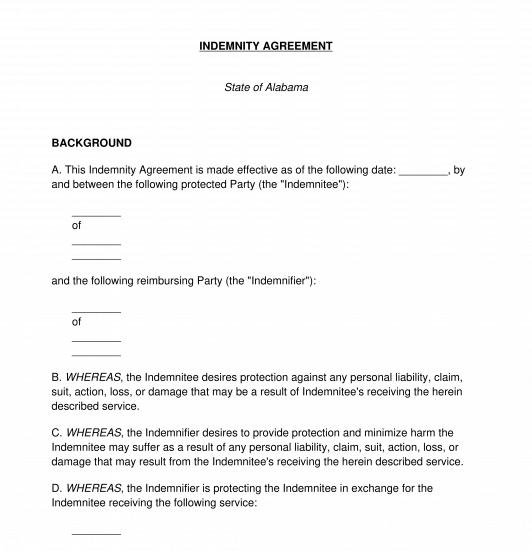 09/02/2025
09/02/2025

Answer a few questions and your document is created automatically.

Your document is ready! You will receive it in Word and PDF formats. You will be able to modify it.

 09/02/2025
09/02/2025
 Word and PDF
Word and PDF
 6 to 9 pages
6 to 9 pages



An Indemnity Agreement is a document used to protect one party, known as the indemnitee, from liability based on the actions of another party, known as the indemnifier. Providing this protection is a process known as indemnification. When the indemnifier agrees to indemnify the indemnitee, they are promising that they will reimburse the indemnitee for any lawsuits or claims that arise as a result of the indemnitee engaging in an agreed-upon activity.
An Indemnity Agreement can be used in a wide range of situations, including the indemnitee providing or receiving services, allowing the indemnifier to use their property, or entering into a contractual agreement. For example, one party might agree to let another party use their home to throw a reception. The party throwing the reception can agree to indemnify the party whose home they are using against any claims that may come up because of accidents or mishaps that occur during the reception. If one of the attendees were to trip and break their leg, leading to a personal injury lawsuit, the indemnifier would be responsible for paying for all expenses resulting from the lawsuit, including hiring legal counsel and paying out any settlements, even though the injury happened on the indemnitee's property.
There are two major exceptions that would lead the indemnifier to not be responsible for indemnifying the indemnitee under their Agreement. The first exception is if the indemnitee performs actions in a negligent or intentionally reckless manner. The second exception is, in the case of a criminal lawsuit, the indemnitee having had reasonable cause to believe that their conduct was fraudulent or criminal. In these situations, the indemnifier would not be obligated to reimburse the indemnitee for expenses related to these claims.
An Indemnity Agreement can be beneficial for both parties. Usually, the indemnifier wants the indemnitee to participate in an activity but the indemnitee is reluctant because of potential liability. The indemnifier agrees to indemnify the indemnitee against any liability that might result from participation in the activity. This way, the indemnifier is able to convince the indemnitee to participate in the activity while the indemnitee is reassured that they will not be held liable if something goes wrong in the process.
While similar to a Release Agreement, an Indemnity Agreement is made prior to the activity happening while a Release Agreement is made after the activity has already occurred and a lawsuit or claim has resulted.
How to use this document
This document covers all of the important information necessary for an indemnitee to be protected from liability by an indemnifier through the process of indemnification, including the following details:
The indemnitee and indemnifier can discuss the terms of the Agreement and create and sign the final Agreement prior to the indemnitee engaging in the agreed-upon activity.
After inputting the required information, this Agreement is printed out and signed by both Parties, and then kept on file by both parties for the duration of the Agreement as well as for a reasonable period of time thereafter.
Applicable law
Indemnity Agreements in the United States are generally subject to specific state laws, but the general form of an Indemnity Agreement is often similar across states.
How to modify the template
You fill out a form. The document is created before your eyes as you respond to the questions.
At the end, you receive it in Word and PDF formats. You can modify it and reuse it.
Indemnity Agreement - FREE - Template - Word & PDF
Country: United States